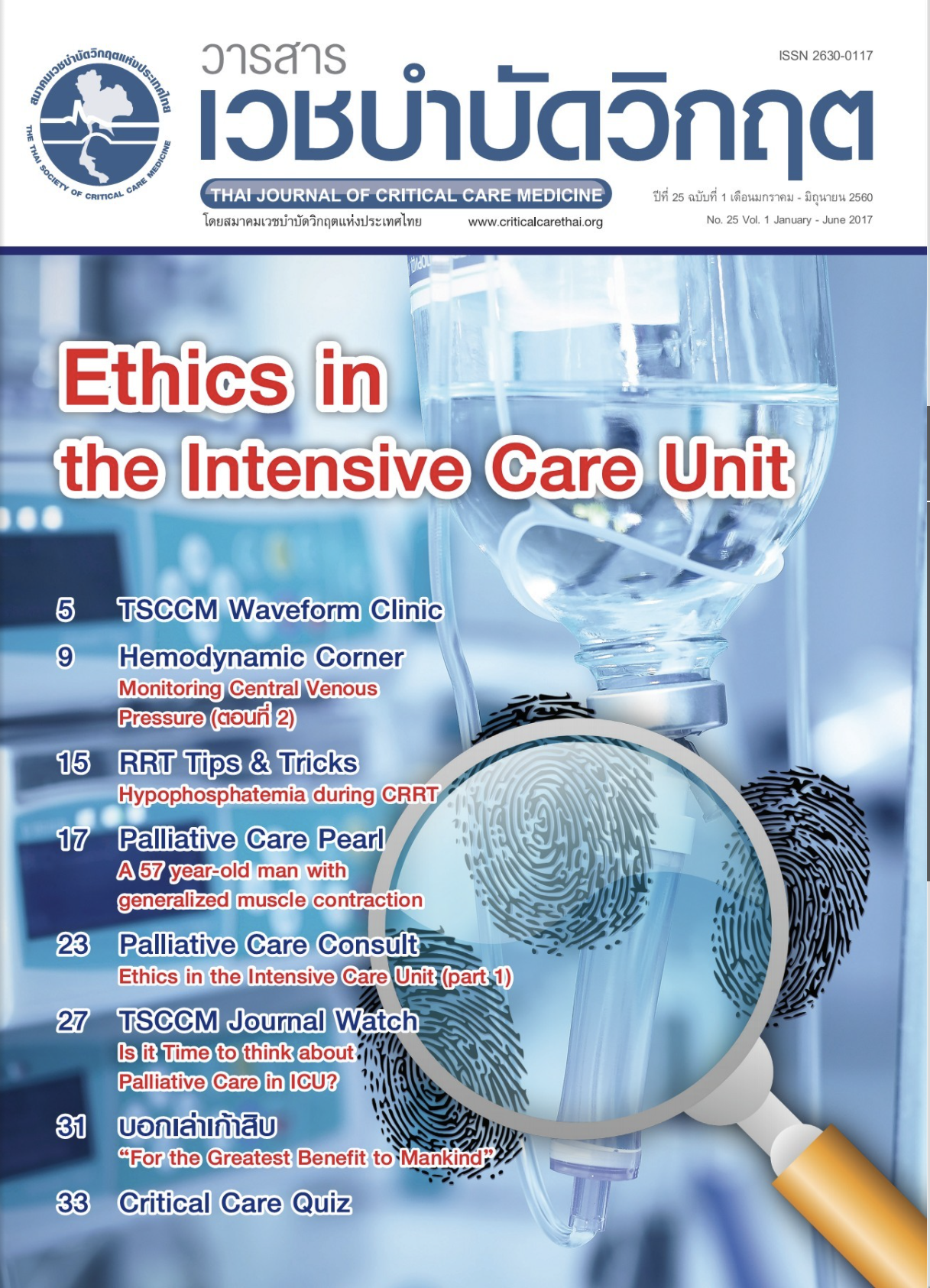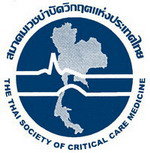Is it time to think about Palliative Care in ICU?
Abstract
เป็นที่ทราบดีว่าผู้ป่วยที่เข้ารับการรักษาตัวในหอผู้ป่วยหนัก จะมีผู้ป่วยส่วนหนึ่งที่เสียชีวิตในหอผู้ป่วย อีกส่วนหนึ่งสามารถรอดชีวิตออกจากหอผู้ป่วยหนักได้ ในผู้ป่วยที่รอดชีวิตนี้ยังมีอีกจำนวนหนึ่งที่เสียชีวิต ในภายหลัง แม้ไม่เสียชีวิตก็จะมีส่วนหนึ่งที่ไม่สามารถกลับไปใช้ชีวิตตามปกติได้ ซึ่งข้อมูลต่าง ๆ ทางการแพทย์ที่เกี่ยวกับการรักษาผู้ป่วยในหอผู้ป่วยหนัก มักมุ่งเน้นไปที่การรักษาที่อัตราการรอดชีวิตจากหอผู้ป่วย หรือการรอดชีวิตที่ 28 วันเป็นหลัก แต่ข้อมูลที่จะบ่งชี้ถึงสมรรถนะผู้ป่วยในระยะยาวนั้นมีจำกัด ซึ่งแท้จริงแล้วอัตรารอดชีวิตระยะยาวเป็นสิ่งสำคัญ ที่ช่วยการวางแผนการรักษาได้ดียิ่งขึ้น รวมถึงการพิจารณาว่าผู้ป่วยสมควรได้รับการดูแลรักษาแบบ Palliative care หรือยัง
Downloads
References
World Health Organization. WHO definition of palliative care. Website: http://www.who.int/cancer/palliative/definition/en/ (accessed Feb 2017).
Lanken PN, Terry PB, Delisser HM, Fahy BF, Hansen-Flaschen J, et al. ATS End-of-Life Care Task Force. An official American Thoracic Society clinical policy statement: palliative care for patients with respiratory diseases and critical illnesses. Am J Respir Crit Care Med. 2008; 177: 912-927.
Aslakson RA, Curtis JR, Nelson JE. The changing role of palliat ive care in the ICU. Crit Care Med. 2014;42(11):2418–2428.
Min H, Avramovic S, Wojtusiak J,et al. A Comprehensive Multimorbidity Index for Predicting Mortality in Intensive Care Unit Patients. J Palliat Med. 2017;20(1):35-41. Epub 2016 Dec 7.
Downar J, Goldman R, Pinto R, Englesakis M, Adhikari NKJ. The “surprise question” for predicting death in seriously ill patients: a systematic review and meta-analysis. CMAJ 2017;189(13):E484-E93.
Detsky DME, Harhay DMO, Bayard DDF, Delman MAM, Buehler MAE, Kent MSA, et al. Six-month morbidity and mortality among ICU patients receiving life-sustaining therapy: A prospective cohort study. Ann Am thorac Soc. 2017:[in press].
Quill TE, Abernethy AP. Generalist plus specialist palliative care-creating a more sustainable model. N Engl J Med. 2013;368(13): 1173–1175.
Ferrand E, Lemaire F, Regnier B, et al. Discrepancies between perceptions by physicians and nursing staff of intensive care unit end-of-life decisions. Am J Respir Crit Care Med. 2003;167(10):1310–1315.
Curtis JR, Back AL, Ford DW, et al. Effect of communication skills training for residents and nurse practitioners on quality of communication with patients with serious illness: a randomized trial. JAMA. 2013;310(21):2271–2281.
Hart JL, Harhay MO, Gabler NB, et al. Variability among US intensive care units in managing the care of patients admitted with preexisting limits on life-sustaining therapies. JAMA Intern Med. 2015; 175(6):1019–1026.
Nelson JE, Curtis JR, Mulkerin C, et al. Choosing and using screening criteria for palliative care consultation in the ICU: a report from the Improving Palliative Care in the ICU (IPAL-ICU) advisory board. Crit Care Med. 2013; 41(10):2318–2327.
Wysham NG, Hua M, Hough CL, Gundel S, Docherty SL, Cox CE et al. Improving intensive care unit-based palliative care delivery: a multi-center, multidisciplinary survey of critical care clinician attitudes and beliefs. Crit Care Med. 2017;45(4):e372-e8.
Nelson JE, Cortez TB, Curtis JR, et al. Integrating palliative care in the ICU: The nurse in a leading role. J Hosp Pall Nurs. 2011;13(2): 89–94.
Baldwin MR, Narain WR, Wunsch H, Schluger NW, Cooke JT, Maurer MS, et al. A prognostic model for 6-month mortality in elderly survivors of critical illness. Chest. 2013;143(4):910-9.
Hua MS, Li G, Blinderman CD, et al. Estimates of the need for palliative care consultation across United States intensive care units using a trigger-based model. Am J Respir Crit Care Med. 2014;18 9(4):428–436.





